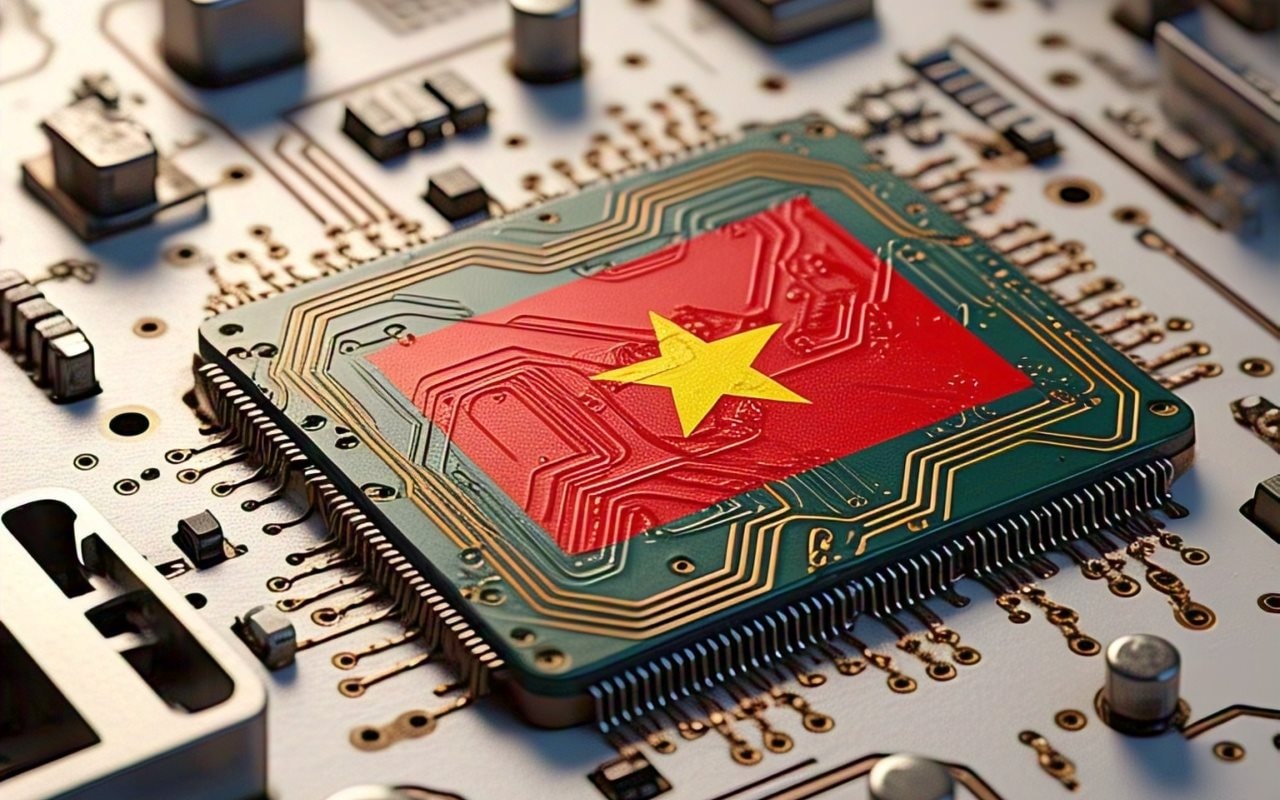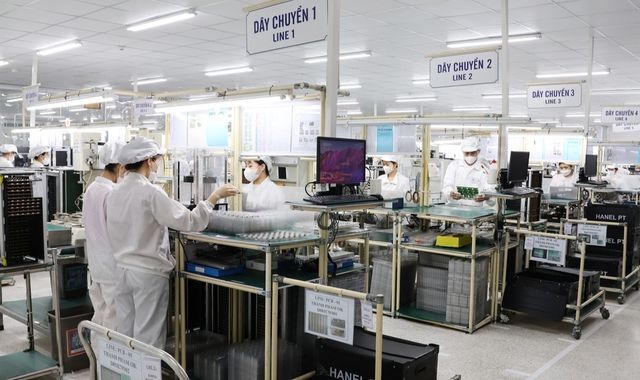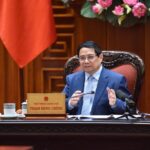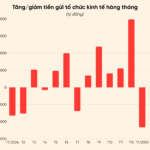
Illustration by AI
Bac Ninh to Become a Leading Hub for Microchip and Semiconductor Manufacturing
The People’s Committee of Bac Ninh province has recently issued Plan No. 323/KH-UBND for the development of the semiconductor industry in Bac Ninh province by 2030, with a vision towards 2045.
The plan aims to transform Bac Ninh into a strategic hub for Vietnam’s semiconductor industry, establishing a modern ecosystem for microchip and semiconductor component manufacturing, and enhancing the province’s global competitiveness.
During the period from 2025 to 2030, Bac Ninh strives to become the northern hub for the semiconductor industry, leading the way in Vietnam. The province focuses on attracting in-depth investment, developing concentrated information technology parks, and building a state-of-the-art semiconductor ecosystem.
Concurrently, Bac Ninh is committed to training engineers and microchip experts, preparing a high-quality workforce, and gearing up for a wave of foreign investment from major technology corporations. The province continues to attract foreign investment, encouraging existing investors to expand their operations in Bac Ninh, with a focus on corporations and businesses that are pioneers in the semiconductor industry.
By 2030, the province aims to train a minimum of 30,050 workers in the semiconductor industry, with 1.8% holding bachelor’s degrees, 43.3% with college degrees, and 54.9% with intermediate and advanced vocational qualifications; forming a supporting semiconductor industry cluster, reducing dependence on imported components and raw materials.
Additionally, Bac Ninh aims to attract 3-5 large technology corporations to invest in factories and R&D centers in the province or encourage existing investors to expand their operations; developing Bac Ninh into a leading hub for microchip manufacturing and exports in the region…
From 2030 to 2045, Bac Ninh sets its sights on becoming a leading hub for microchip and semiconductor manufacturing in the region, with the establishment of billion-dollar chip factories and the gradual mastery of core technologies. The province will gradually integrate into the global semiconductor supply chain, exporting semiconductor products bearing the “Made in Vietnam” label.

To achieve these goals, Bac Ninh plans to implement various measures such as tax exemptions and reductions for companies investing in the semiconductor industry; preferential import tax rates for high-tech components and equipment used in research and production; and the application of a “Green Channel 60%” mechanism for procedures, projects, and tasks related to the development of the semiconductor industry. Simultaneously, the province will develop special incentive policies in the semiconductor field for startup and manufacturing enterprises.
Furthermore, the province focuses on developing semiconductor industrial infrastructure and green technology infrastructure, prioritizing renewable energy in microchip manufacturing. At the same time, it ensures the provision of essential infrastructure and Internet connectivity that meets international standards to cater to high-tech production. The province also plans to establish a Research and Development (R&D) center in the field of microchips and semiconductor manufacturing.
In tandem, Bac Ninh is actively attracting new investments or encouraging existing businesses to expand their operations in the province; fostering extensive cooperation, promoting trade, technology transfer, human resource training, and import-export activities with developed partners.

An Emerging Industry in Vietnam
Vietnam’s semiconductor chip industry is experiencing robust growth in recent years. According to the development plan for the semiconductor industry, the scale of revenue in Vietnam’s semiconductor industry during the period of 2024-2030 is expected to exceed $25 billion per year, with a value addition of 10-15% in Vietnam. The scale of revenue in Vietnam’s electronics industry is projected to surpass $225 billion per year, with a value addition of 10-15% in the country.
By 2040, the revenue scale of Vietnam’s semiconductor industry is targeted to reach over $50 billion per year, with a value addition of 15-20% in Vietnam. The revenue scale of the electronics industry is expected to exceed $485 billion per year, with a value addition of 15-20% in the country. The workforce in this sector is projected to comprise over 100,000 engineers and bachelor’s degree holders with a suitable structure and quantity to meet the industry’s demands.
By 2050, the revenue scale of Vietnam’s semiconductor industry is aimed to surpass $100 billion per year, with a value addition of 20-25% in Vietnam; the revenue scale of the electronics industry is projected to exceed $1,045 billion per year, with a value addition of 20-25% in the country. By this stage, there will be at least 300 semiconductor design companies, 3 semiconductor chip manufacturing plants, 20 semiconductor product packaging and testing plants, and more…

Currently, numerous prominent companies in the global semiconductor industry have invested in Vietnam. According to the Ministry of Planning and Investment, as of the end of 2024, there were 174 FDI projects registered in the semiconductor sector, with a total investment of nearly $11.6 billion. Major players in the industry, including Intel, Marvell Technology, Samsung, CoAsia SEMI (South Korea), and Renesas (Japan), have already established a presence in Vietnam. Vietnam is recognized as a potential hub for the world’s new semiconductor manufacturing during the period of 2024-2030.
In a sharing session, Mr. Amit Laroya, Senior Vice President for Asia in the Transportation and Electronics sector of 3M Corporation, stated that Vietnam is a market of particular interest to businesses participating in the global semiconductor ecosystem.
Sharing the same viewpoint, Mr. Richard Lawton Thurston, former Vice President of TSMC from Taiwan, also expressed that Vietnam has a great opportunity to develop its semiconductor and AI industries. “The development of AI requires various technologies, including sensors, memory, data collection, and processing. Therefore, Vietnam should choose one of these stages to focus on and develop a strategic direction,” said Mr. Thurston.
Unlocking New Opportunities for Vietnamese Durian in the Chinese Market
The king of fruits, durian, is set to conquer new territories as Vietnam’s durians gain traction in the massive Chinese market. With nearly 1,000 approved codes, the fragrant and flavorful Vietnamese durians are now poised to tantalize the taste buds of Chinese consumers, presenting a golden opportunity for the country’s farmers and exporters alike.
Prime Minister Pham Minh Chinh: Positive Signals from Trade Talks with the US
Prime Minister Pham Minh Chinh has expressed optimism about the recent tariff negotiations with the United States, stating that there are positive signs emerging from the talks. Both countries are working diligently to bring the negotiations to a conclusion as soon as possible.





















